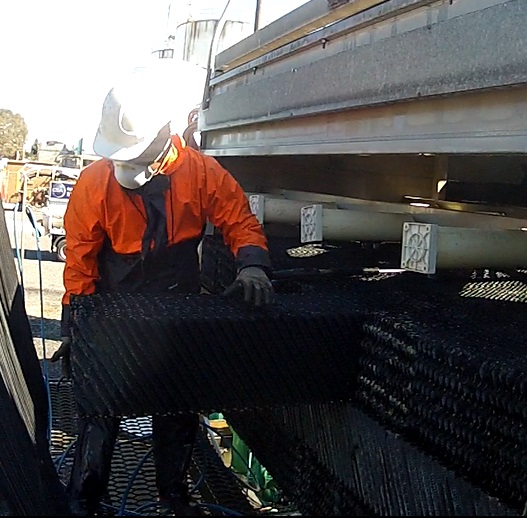Energy and Water Savings
Energy
Cooling equipment requires electrical power to operate fan motors, compressors, and pumps.
On day one a brand-new cooling unit installation is operating at 100% cooling performance.
Your cooling equipment is at 100% energy consumption efficiency.
The unit is clean, 100% free of dirt and contaminants.
What happens after day one?
Energy costs go up. Why?
The cooling performance starts to decrease!
You require more energy to perform the original design cooling duty!

Cleaning coils every year is critical to reduce electricity costs
Cooling equipment has some standard components
- Heat transfer medium (coil or fill pack).
- A fan to move air over the heat transfer medium (coil or fill pack).
- Water cooled units use water distribution systems to increase the heat rejection. They distribute water over the (coil or fill pack).

Any hole in air intake louvres cause water
and chemical loss onto the ground or platforms

Dirty and fowled fill pack increases water usage
and electrical power costs – It must be clean to avoid excessive costs

Blocked water distribution nozzles increase
the cost of electricity to run a cooling tower or chiller
Energy usage is increased by the following factors.
- Dirt – dust – scale
- Bacteria – biofilm – slime – mould
- Corrosion – erosion
- Pollution – chemical attack
- Wear – tear – damage – faults
- Mechanical faults – electrical faults

Water and chemicals being lost onto the ground
from faulty air intake louvre and water distribution nozzles

Corrosion in hot water distribution deck is causing the water to bypass the nozzles
As cooling performance drops, the cost of energy usage increases.
From day one, the operation of cooling equipment is being put to stress by all the above factors.
Why are the energy cost increases?
- The cooling equipment has to run longer and harder to do the work that was easy on day one of installation.
- Wear and tear rates increase as the unit needs to work harder. Wear and tear make it harder for the unit to work efficiently so energy cost increases.
- Bacteria, biofilm, slime, and mould grows faster at higher temperatures, so surfaces are fouled causing energy cost to increases.
- The cooling units are now not cooling effectively so all the associated equipment energy usage costs increase as well. Chillers, compressors, cool rooms, offices, stores, buildings.
Water
Considering all the above, why does the water usage cost increase for water cooled units.
As the cooling performance decreases the operational temperatures increase. Water usage cost increases.
- Higher temperatures cause higher water evaporation rates. Water loss cost
- Water evaporation causes scaling on coils, fill pack and general surfaces.
- Scaled steel and aluminium surfaces start to corrode and fail.
- Scaled coils struggle to cool causing high energy usage and increased water usage.
- Heat, scale, wear, and tear cause the structure to move, deform, and seams / joints to start to leak water out of the unit.
- Water loss is directly proportional to chemical loss from a unit. Chemical costs increase.
- Water and chemical loss into the environment is an EPA issue.
- The cost of fines imposed by the EPA for waste cooling tower water and chemical loss into the environment is significant.
Without maintenance and cleaning of cooling equipment, the energy and water costs are increasing.
Maintenance and cleaning are critical to ensure that cooling equipment runs as close as possible to the meet 100% performance mark to reduce energy usage and to reduce water usage costs.

